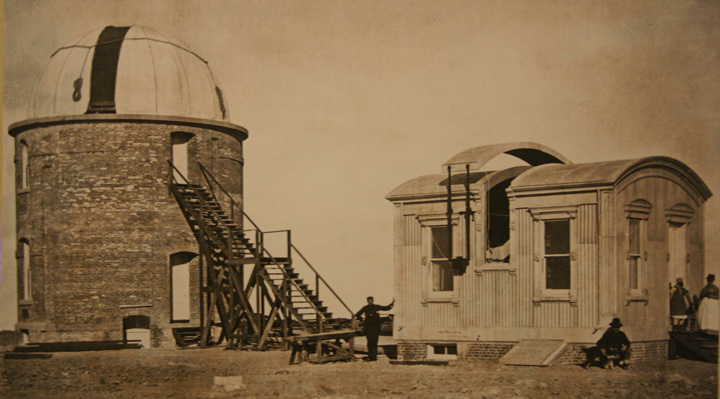
For more history of Lick Observatory, please see our Web site.
We also have photos and documentation relating to the 36" Crossley telescope, one of the three historical telescopes on Mt. Hamilton..
The 12" Telescope
The 12" telescope was, in fact, a hand-me-down. Alvan Clark originally made the object glass in 1875 for a wealthy Upstate New York amateur astronomer, Dr. Henry Draper. Draper was interested in astrophotography, and traded the 12" for a photographically corrected 11" lens, also made by Clark. Richard Floyd, the president of the Lick Trust, was pleased to get such a superior telescope at a second-hand price! The tailpiece pictured above is thought to have been dated prior to the telescope being reworked before delivery to Lick in 1881.
The telescope was first used for scientific purposes by Sherburne Burnham, an amateur astronomer of great reputation who had originally done the site testing at Mt. Hamilton. The event he witnessed was the planet Mercury transiting the Sun on November 7, 1881. The results, which assisted astronomers in calculating distances in the Solar System, were the first published scientific results from Lick Observatory.
This was not the first time, however, that observation had been made through the 12" telescope. The privilege fell to King Kalakaua of Hawaii, which was still an independent island chain. Richard Floyd had met him several years earlier on a trip to Hawaii, and when the King wanted to visit Mt. Hamilton, he was warmly received by Floyd. The 12" was temporarily set up in the unfinished dome for the pleasure of the King, and he was delighted with his visit.
The second scientific use of the telescope was to observe the transit of Venus across the face of the Sun. December 6, 1882, marked the second of a pair of transits occurring eight years apart. The transit would not occur again for 130 years, so it was indeed a historical heavenly event. The observation was made and photographed by David Todd, professor of astronomy at Amhurst College in Massachusetts.
Once the 36" telescope began operation in January of 1888, the 12" telescope was relegated to secondary status. It is a beautiful piece of workmanship, with optics by one of the master lensmakers of all time. The Lick Shops are honored to be working on its renovation.
The 12" Dome
The year was 1881. As the world's first mountaintop observatory, Lick Observatory faced a couple of logistical problems at the outset of its construction: the transport of building materials up the 19-mile, steep and winding road (Lick Avenue, now Mt. Hamilton Road). At the time of year when early construction was taking place, harsh winter weather also played a role in thwarting construction efforts.
The discovery of a nearby spring and clay bed made all the difference in the world. Thomas Fraser, the superintendent of construction, had a kiln set up; luckily, the bricks it produced were of good quality. The workmen soon began producing up to 10,000 bricks per day.
The 12" dome, pictured above, consisted of 32,000 bricks circling upward to form a cylindrical tower 25 feet in diameter and two stories high. The dome was turned by a loop of steel cable that wrapped around the exterior and a wheel mounted in a recess in an interior wall. The dome was spun by cranking the wheel. The turning mechanism, plus the metal track and rollers, were designed by Richard Floyd and Thomas Fraser, and built by Worcester Warner and Ambrose Swasey. This was an innovative design that later was adopted by many other observatories. The telescope was mounted in the dome in October, 1881.
This same dome now houses the 40" Anna L. Nickel reflecting telescope, installed in 1979. It is a testament to the skill and knowledge of Thomas Fraser and the workers who build the dome that, not only is it still standing (having survived several earthquakes over the years), but it is also very much in use.